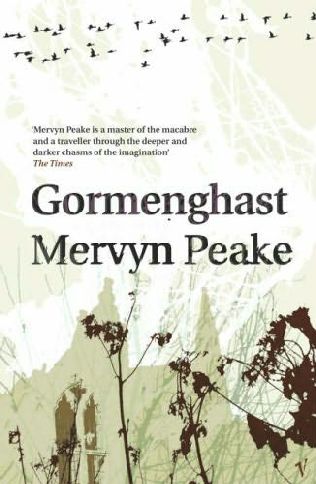 Titus the seventy-seventh. Heir to a crumbling summit: to a sea of nettles: to an empire of red rust: to rituals' footprints ankle-deep in stone.
Titus the seventy-seventh. Heir to a crumbling summit: to a sea of nettles: to an empire of red rust: to rituals' footprints ankle-deep in stone.
Gormenghast.
Withdrawn and ruinous it broods in umbra: the immemorial masonry: the towers, the tracts. Is all corroding? No. Through an avenue of spires a zephyr floats; a bird whistles; a freshet bears away from a choked river. Deep in a fist of stone a doll's hand wriggles, warm rebellious on the frozen palm. A shadow shifts its length. A spider stirs...
And darkness winds between the characters.It occurred to me upon re-reading my review of the first book in this trilogy,
Titus Groan, that either my review seems more negative than I truly felt or I have warmed up to the book considerably since I read it. In retrospect my complaints seem a little pedantic, and I would argue to myself that the series' flaws are well compensated by its virtues: an endless exhibition of creativity and ingenuity, and an obliquely poetic sense of description. Comparing Peake's books to
Harry Potter, I remarked that they lack Rowling's "affability"; now I wonder why a book as unique as this would need to be affable.
So let's consider this a fresh slate, and let me explain what I do enjoy about these books:
In the first book,
Titus Groan, Titus is recently born to the Earl and Countess of Gormenghast, a vast castle at the foot of Gormenghast mountain. As a baby, he doesn't do much, but there is no doubt that he will be an important figure for the castle; as the only heir to the Earl he will inherit all of the castle and its ancient system of ritual. Ironically, it is Titus who is the main character of
Gormenghast, but the castle fills the central role in
Titus Groan. It is many miles across, and houses untold thousands; there are parts of it that haven't been seen by human eyes in decades. Titus, aged 11 and feeling a bit of wanderlust, strolls into one such part of the castle in
Gormenghast that is overrun by nature:
There had once been a great casement facing upon this terrace. It was gone. Neither broken glass nor iron nor rotten wood was anywhere to be seen. Beneath the moss and ground creepers it may be that there were other and deeper layers, rotten with antiquity; but where the long window had stood the hollow darkness of a hall remained. It opened its unprotected mouth midway along the pavement's inner verge. On either side of this cavernous opening, widely separated, were the raw holes in the stonework that were once the supporting windows. The hall itself was solemn with herons. It was there they bred and tended their young. Preponderately a heronry, yet there were recesses a nd niches in which by sacredness of custom the egrets and bitterns congregated.
I have complained that Rowling doesn't have the chops to provide the sense of awe and wonder that Hogwarts deserves; in fact she wastes very little ink on describing it at all. Peake succeeds in that, and the various rooms and hallways of Gormenghast provide some of the books' most captivating passages. Like Hogwarts, it is riddled with secret passageways and bizarre corners; one of my favorites is the tallest part of the castle, the Tower of Flints, where the Death Owls live who pick into oblivion anyone condemnded to death. Elsewhere it is a labyrinth of chambers, attics, roofs, and quadrangles.
The passage about the herons provides subtle commentary on the state of the castle, which, like its inhabitants, has a troubled soul: the egrets and bitterns gather "by sacredness of custom," as the castle itself is guided by thousands of pages of rituals which determine the operation of every event in the castle. All these rituals are kept by an old man named Barquentine, the Master of Ritual; and Peake suggests that this is where the real power in the castle lies. Many of these rituals involve Titus, who, as a baby at the end of the first book, unceremoniously drops the symbols of ritual into a lake, foreshadowing his rejection of the castle's antiquated laws as a teenager. But the castle is crumbling in places, and has let the herons in with nature. Ritual cannot keep it alive forever.
The most interesting character, however, is Steerpike, who in
Titus Groan is depicted as a handsome and serious youth who, through a campaign of deceit, manages to work his way up from kitchen boy to Barquentine's assistant, making him heir to the position of Master of Ritual. Steerpike lusts after power, but it is a cold lust; he has infinite patience and works cleverly over the progressing years to procure positions of increasing power. We find out at the beginning of
Gormenghast that he has faked the deaths of Cora and Clarice, the deceased Earl's moron sisters, and shut them up in an unfrequented part of the castle telling them that he is protecting them from a rash of "Weasel Plague," but we know that when they become too complicated to keep alive he will murder them without pity. He has no remorse, and indeed no emotions beyond a determined and robotic drive for power.
He is, in a word, badass. Here is a passage I liked that I think does his character justice:
The sun was blocked away. For a few minutes the shadow disappeared like the evil dream of some sleeper who on waking finds the substance of his nightmare standing beside his bed -- for Steerpike was there, turning the corners, threading the mazes, gliding down slopes of stone or flights of rotten wood. And yet it was strange that with all the vibrancy that lay packed within the margins of his frame, yet his shadow when it reappeared reaffirmed its self-sufficiency and richness as a scabbard for malignity. Why should this be -- why with certain slender proportions and certain tricks of movement should a sense of darkness be evoked? Shadows more terrible and grotesque than Steerpike's gave no such feeling. They moved across their walls bloated or spidery with a comparative innocence. It was as though a shadow had a heart -- a heart where blood was drawn from the margins of a world of less substance than air. A world of darkness whose very existence depended upon its enemy, the light.
Peake's writing has such richness, such evocativeness that really brings out the strangeness of the world he has created. There is no magic, and no races other than humans, but this must be fantasy because it feels so very fantastic; there is no mistaking Gormenghast for a castle of medieval Europe. In fact, I think it makes "real" fantasy books look rather bland by comparison.
The BBC did a miniseries called
Gormenghast that conflated both books; Jonathan Rhys-Meyers played Steerpike, which I think is a perfect casting choice. But I can't decide if I'd like to see it, because I think that it might ruin a lot of the images in my head. What it really needs is a big, multi-film Peter Jackson epic. I'd totally watch that.
 I don't read to many comic books and this is the first graphic novel I have ever read, but I recently married this guy who loves both mediums of literature. This fact combined with seeing The Dark Knight got me interested in reading The Long Halloween.
I don't read to many comic books and this is the first graphic novel I have ever read, but I recently married this guy who loves both mediums of literature. This fact combined with seeing The Dark Knight got me interested in reading The Long Halloween.


 Milo is blasé attitude about life in general. But one day, upon coming home from school, he finds a mysterious package waiting for him. Inside is a tollbooth that ushers him into another world, a world of witches and monsters and princesses. But this world hinges on some of the very things that Milo finds utterly uninteresting: the importance of words and numbers.
Milo is blasé attitude about life in general. But one day, upon coming home from school, he finds a mysterious package waiting for him. Inside is a tollbooth that ushers him into another world, a world of witches and monsters and princesses. But this world hinges on some of the very things that Milo finds utterly uninteresting: the importance of words and numbers. In the 1970s Herbert Terrace, a professor at Columbia University, decided to try to prove that language was not specific to humans, but that animals could learn it as well. Terrace came from the B. F. Skinner school of thought, that is to say he was a behaviorist who thought that language could be learned. If B. F. Skinner was at one end of the spectrum, then Noam Chomsky was at the other. Chomsky held that language was a uniquely human construct.
In the 1970s Herbert Terrace, a professor at Columbia University, decided to try to prove that language was not specific to humans, but that animals could learn it as well. Terrace came from the B. F. Skinner school of thought, that is to say he was a behaviorist who thought that language could be learned. If B. F. Skinner was at one end of the spectrum, then Noam Chomsky was at the other. Chomsky held that language was a uniquely human construct.









